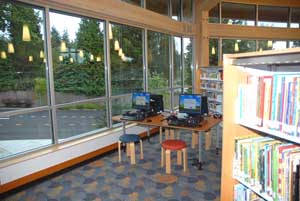On September 11, 2010, a public open house celebrates the opening of the new $3.2 million Lake Hills Library, located at Lake Hills Village, on the corner of 156th Avenue SE and Lake Hills Boulevard in East Bellevue. The celebration, attended by approximately 1,000 community members, features a formal ribbon cutting with speeches, followed by an open house with music and refreshments. Lake Hills Village is a redevelopment of the old Lake Hills Shopping Center and is conceived as an "urban village" with a mix of residential, office, and retail users. The new 10,000-square-foot library, funded by a $172 million capital-bond measure approved in 2004, is the anchor tenant for the new mixed-use development.
Creating an Urban Village
Lake Hills Shopping Center was a 6.7-acre facility that opened in 1958. Among its anchor tenants was the very first QFC grocery store. But over time the center could not compete with larger centers and big-box stores opening in the region. In 2001, the QFC closed. Most of the other stores left as well.
In 2000, the City of Bellevue approached Cosmos Development about redeveloping the Lake Hills Shopping Center, and subsequently the center was rebranded as Lake Hills Village. The concept was to create an urban village where people could live, work, and shop in the same area. As of 2016, Lake Hills Village was still in the process of organizing around mixed use by retail, office, and residential users, including plans for an outdoor stage for performances. "The idea is to create neighborhoods with less reliance on cars and provide gathering places for people to linger, as they might have in a town square" (Bartley).
The original Lake Hills Library, then known as Cascade Library, opened in 1960 in the back room of the Lake Hills Community Club. At that time, Lake Hills was a fairly homogeneous suburban outpost, relatively far from the urban center of Seattle or even downtown Bellevue. Even in 1968, when the Lake Hills Library opened in its first standalone library building several blocks east of the Lake Hills Shopping Center, the Lake Hills neighborhood was not yet formally annexed to the City of Bellevue -- that came one year later, in 1969.
In 2004, King County voters approved a $172 million library bond, which funded many projects, including a new $3.2 million Lake Hills Library. Although initially delayed by the recession of 2008, this library was nonetheless the anchor tenant and one of the first completed projects in the redeveloped Lake Hills Village. It was located approximately at the site formerly occupied by the first QFC -- a clear sign of the differences between the suburban shopping center of the 1950s and 1960s and the "urban village" of the twenty-first century.
The New Library
The shell of the new $3.2 million, 10,000-square-foot Lake Hills Library was designed by Baylis Architects and ZGF Architects "completed the space planning and interior work" ("Delivering on a Promise ...)." The new library, built with sustainable materials, had a cantilevered ceiling and exposed natural wood beams and allowed in ample natural light. It featured a large computer area, a teen area, a children's area with dedicated children's computers, a meeting room, and study rooms.
As of 2016, the Lake Hills Library at Lake Hills Village was being used by the very diverse population of East Bellevue, as well as by students from nearby Bellevue College. About two-thirds of the way up the west wall of the new library, just below a row of high windows, the library building displayed as a permanent art installation a multi-panel black-and-white mural depicting such diverse items as a pair of high-heeled shoes, a freeway overpass, and a playground ladder and slide. Titled "Encyclopedia of Ramps," this was a series of drawings on aluminum by Lead Pencil Studio, an art-and-architecture collaborative venture. According to a recent KCLS book on art in the libraries, Lead Pencil Studio's "intriguing works often portray the unexpected, or what seems missing, such as a billboard without advertising, a stairway without steps, or building's scaffolding, with the intent of creating visual spaciousness and leading the viewer to a new way of seeing" (Art in Libraries, 40). As of 2016, both in its look and in its programming, the Lake Hills Library had achieved a spaciousness that encouraged its diverse users to think big and to imagine many possibilities.

